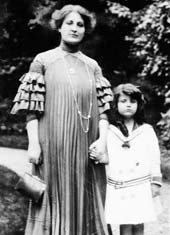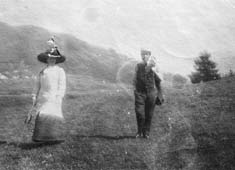| Alma Mahler-Werfel 1901 - 1911 Alma, »the most beautiful girl in Vienna«, took a bold step, causing a sensation in the Vienna of the day: 1902 she married Mahler who, as Director of the Royal Opera, held one of the most powerful positions in the Viennese music scene. Alma was to share with him the last nine years of his life. The price she paid was high. She had to give up her own artistic aspirations, and the desire to become a composer herself was nipped in the bud. Mahler wished her to be a housewife and mother, not a rival. Alma gave him two daughters, one of whom died young, while the other, Anna, became a sculptress.
The result of this was an encounter between Gustav Mahler and Sigmund Freud, who was consulted by Mahler after the revelation of the relationship between Alma and Gropius. This meeting is very mysterious; it took place in the Dutch health resort of Leiden, and lasted just four hours. Scarcely any documents exist revealing exactly what took place, but it becomes evident that Freud penetrated the essence of the relationship, which was marked by a mutual longing for a father and mother substitute. Alma and Mahler had thus been living under the shadow of the taboo of incest. In February 1911, in New York, Mahler fell ill with slow endocarditis, initially diagnosed as influenza. Alma sailed with him from New York back to Europe, where Mahler died in Vienna on 18 May 1911.
|

